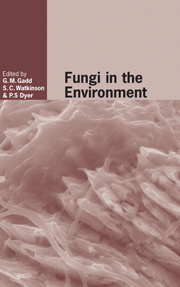Book contents
- Frontmatter
- Contents
- List of contributors
- Preface
- I Imaging and modelling of fungi in the environment
- II Functional ecology of saprotrophic fungi
- III Mutualistic interactions in the environment
- IV Pathogenic interactions in the environment
- V Environmental population genetics of fungi
- VI Molecular ecology of fungi in the environment
- 17 Fungi in the hidden environment: the gut of beetles
- 18 A saltmarsh decomposition system and its ascomycetous laccase genes
- Index
- References
18 - A saltmarsh decomposition system and its ascomycetous laccase genes
from VI - Molecular ecology of fungi in the environment
Published online by Cambridge University Press: 03 November 2009
- Frontmatter
- Contents
- List of contributors
- Preface
- I Imaging and modelling of fungi in the environment
- II Functional ecology of saprotrophic fungi
- III Mutualistic interactions in the environment
- IV Pathogenic interactions in the environment
- V Environmental population genetics of fungi
- VI Molecular ecology of fungi in the environment
- 17 Fungi in the hidden environment: the gut of beetles
- 18 A saltmarsh decomposition system and its ascomycetous laccase genes
- Index
- References
Summary
Introduction
The saltmarshes of the Georgia, USA, Atlantic coast are expansive and highly productive. The marshes form the intertidal ecosystem 5–10 km wide extending from the barrier-island chain to the mainland. The predominant macrophyte of the marshes is smooth cordgrass (Spartina alterniflora Loisel.). Cross-marsh average annual production of smooth cordgrass shoots in Georgia has been measured at approximately 1.3 kg m− 2 of marsh (Newell, 2001a, from Dai & Wiegert, 1996). Like most grasses, smooth cordgrass does not abscise its leaf blades; they remain attached to the leaf sheath after senescence and death (Newell, 1993, and references therein). As new blades are produced at the apex of shoots, the bottom blades senesce and die, until the whole shoot dies after flowering. Therefore, a large crop of standing-dead litter is available to microbes for decomposition for much of the year (for leaf blades alone, up to 538 g dry mass m− 2) (Newell et al., 1998).
Because smooth cordgrass is produced in an intertidal marsh, one might suspect that tidal flooding would be a major wetting phenomenon for the standing-dead cordgrass leaves. However, the grass shoots extend above the flooding-tidal level most of the time: it is estimated that most of the dead-blade mass is wetted by tides only about 10% of the time on an annual-average basis (Newell et al., 1998).
- Type
- Chapter
- Information
- Fungi in the Environment , pp. 371 - 378Publisher: Cambridge University PressPrint publication year: 2007



